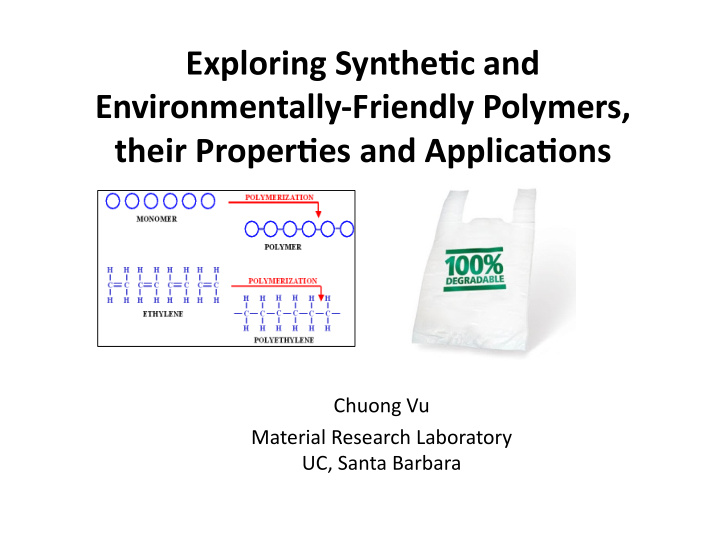



Exploring ¡Synthe0c ¡and ¡ Environmentally-‑Friendly ¡Polymers, ¡ their ¡Proper0es ¡and ¡Applica0ons ¡ Chuong ¡Vu ¡ Material ¡Research ¡Laboratory ¡ UC, ¡Santa ¡Barbara ¡
RET ¡I ¡Research ¡ Polyethylene ¡Glycol ¡(PEG) ¡ • ApplicaAons ¡– ¡cosmeAc ¡products, ¡lubricant, ¡ laxaAves, ¡pharmaceuAcal ¡ • Advantages ¡– ¡not ¡toxic, ¡reduce ¡proteolyAc ¡ degradaAon ¡(opsonizaAon), ¡hydrophilic ¡ PEG ¡Structure ¡
RET ¡I ¡Objec0ves ¡ 1. Synthesize ¡propargyl ¡glycidyl ¡ether ¡(PGE) ¡ 2. Polymerize ¡PGE ¡to ¡create ¡Poly-‑PGE ¡ (backbone) ¡with ¡funcAonal ¡polyether ¡ Propargyl ¡Glycidyl ¡Ether ¡ Poly-‑PGE ¡ ¡ ¡ ¡ ¡ ¡ ¡ ¡ ¡ ¡ ¡ ¡ ¡ ¡ ¡ ¡ ¡ ¡ ¡(PGE) ¡
RET ¡I ¡Objec0ves ¡ Project ¡PEGyla0on ¡ ¡ ¡Current ¡PEGyla0on ¡ H ¡ O ¡ Drug ¡ PGE ¡ Drug ¡ O ¡ O ¡ Drug ¡ PGE ¡ O O ¡ PGE ¡ Drug ¡ O ¡ O ¡ Drug ¡ PGE ¡ O ¡ O PGE ¡ Drug ¡ Drug ¡ O ¡ Drug ¡ PGE ¡
RET ¡I ¡Research ¡to ¡RET ¡II ¡Curriculum ¡ • Polymers ¡are ¡versaAle ¡and ¡crucial ¡in ¡society ¡ • Extensive ¡applicaAon ¡from ¡adhesives, ¡ coaAngs, ¡packaging ¡materials, ¡texAle, ¡ electronic, ¡to ¡biomedical ¡devices ¡ • Generate ¡interest ¡in ¡material ¡science ¡and ¡ polymer ¡science ¡ ¡
RET ¡II ¡Curriculum ¡ Introduc0on ¡to ¡polymer ¡ • Lab ¡1: ¡From ¡Monomers ¡to ¡Polymer ¡ ¡ • Lab ¡2: ¡Making ¡Slime ¡through ¡Cross-‑linking ¡ Applica0on ¡of ¡polymeric ¡materials ¡ • Lab ¡3: ¡Part ¡1 ¡– ¡Oogoo’s ¡Property ¡ ¡ • Lab ¡3: ¡Part ¡2 ¡– ¡Designing ¡Gadgets ¡Using ¡Oogoo ¡ ¡ Polymers ¡for ¡the ¡environment ¡ • Lab ¡4: ¡TesAng ¡Factors ¡that ¡Affect ¡Biodegradable ¡ PlasAc ¡ ¡
Lab ¡1: ¡From ¡Monomers ¡to ¡Polymer ¡by ¡ Polymeriza0on ¡ • ObjecAve: ¡Introduce ¡the ¡concepts ¡and ¡ vocabulary ¡of ¡polymers ¡with ¡simple ¡models ¡ Hand ¡moldable ¡plas0c ¡(polycaprolactone) ¡
Lab ¡1: ¡From ¡Monomers ¡to ¡Polymer ¡by ¡ Polymeriza0on ¡ PVA ¡fibers ¡ Acetone ¡ 4% ¡Polyvinyl ¡Alcohol ¡Sol ¡
Lab ¡1: ¡From ¡Monomers ¡to ¡Polymer ¡by ¡ Polymeriza0on ¡
Lab ¡2: ¡Making ¡Slime ¡through ¡Cross-‑ linking ¡Process ¡ • ObjecAve: ¡Understand ¡cross-‑linking ¡and ¡its ¡ effect ¡in ¡polymers ¡ Cross-‑linked ¡PVA ¡and ¡borax ¡
Lab ¡3: ¡Part ¡1 ¡-‑ ¡Oogoo’s ¡Physical ¡ Property ¡ Hobbyists ¡& ¡do-‑it-‑yourself ¡ enthusiasts ¡ • Marketed ¡as ¡a ¡product ¡to ¡ improve ¡or ¡repair ¡gadgets ¡ • Customize ¡grips, ¡handles, ¡ form ¡unique ¡shapes ¡ • 40 ¡grams ¡= ¡$18 ¡
Lab ¡3: ¡Part ¡1 ¡-‑ ¡Oogoo’s ¡Physical ¡ Property ¡ • ObjecAve: ¡Study ¡characterisAcs ¡of ¡oogoo ¡ polymer ¡using ¡quanAtaAve ¡tests ¡ ¡ = ¡ + ¡ Corn ¡starch ¡ ¡ Oogoo ¡
Lab ¡3: ¡Part ¡1 ¡-‑ ¡Oogoo’s ¡Physical ¡ Property ¡ Use ¡molds ¡for ¡a ¡uniform ¡cylinder ¡diameter ¡to ¡test ¡ compression, ¡insulaAon, ¡and ¡tensile ¡strength ¡ ¡
Lab ¡3: ¡Part ¡2 ¡-‑ ¡Designing ¡Gadgets ¡ Using ¡Oogoo ¡ ¡ • Aaer ¡quanAtaAve ¡tesAng, ¡students ¡will ¡be ¡ challenged ¡to ¡find ¡applicaAons ¡for ¡oogoo ¡ • Use ¡oogoo ¡to ¡create ¡potenAal ¡objects ¡that ¡ have ¡high ¡consumer ¡demand ¡ • Create ¡adverAsement ¡posters ¡or ¡videos ¡to ¡sell ¡ their ¡creaAons ¡
Lab ¡4: ¡Tes0ng ¡Factors ¡that ¡Affect ¡ Biodegradable ¡Plas0c ¡ ¡ • Petroleum ¡based ¡plasAcs ¡do ¡not ¡readily ¡break ¡ apart ¡and ¡small ¡percent ¡are ¡recycled ¡ • Introduce ¡bioplasAcs ¡and ¡biodegrade ¡concepts ¡ to ¡students ¡ • How ¡fast ¡will ¡bioplasAcs ¡degrade? ¡
Lab ¡4: ¡Tes0ng ¡Factors ¡that ¡Affect ¡ Biodegradable ¡Plas0c ¡ ¡ • ObjecAve: ¡Making ¡bioplasAcs ¡(casein) ¡and ¡see ¡ how ¡they ¡degrade ¡under ¡different ¡condiAons ¡ ¡ Low ¡fat ¡milk ¡ ¡Half ¡& ¡Half ¡
Lab ¡4: ¡Tes0ng ¡Factors ¡that ¡Affect ¡ Biodegradable ¡Plas0c ¡ ¡ CondiAons ¡for ¡Biodegradability ¡Test ¡ at ¡room ¡temperature ¡ and ¡under ¡heat ¡ ¡ ¡ ¡ ¡Water ¡ ¡ ¡ ¡ ¡ ¡ ¡Alkaline ¡Salty ¡ ¡ ¡ ¡ ¡ ¡ ¡ ¡solu0on ¡solu0on ¡ ¡
Lab ¡4: ¡Tes0ng ¡Factors ¡that ¡Affect ¡ Biodegradable ¡Plas0c ¡ ¡ • TesAng ¡PVA ¡film ¡in ¡addiAon ¡to ¡casein ¡to ¡show ¡ students ¡decompose ¡ ¡ Polyvinyl ¡alcohol ¡film ¡
So_ ¡Robo0cs ¡ A ¡
Standards ¡ High ¡School ¡Chemistry ¡ • 2.a. ¡Students ¡know ¡atoms ¡combine ¡to ¡form ¡molecules ¡by ¡sharing ¡electrons ¡ to ¡form ¡covalent ¡or ¡metallic ¡bonds ¡or ¡by ¡exchanging ¡electrons ¡to ¡form ¡ ionic ¡bonds. ¡ • 10.a. ¡Students ¡know ¡large ¡molecules ¡(polymers), ¡such ¡as ¡proteins, ¡nucleic ¡ acids, ¡and ¡starch, ¡are ¡formed ¡by ¡repeAAve ¡combinaAons ¡of ¡simple ¡ subunits. ¡ • 10.b. ¡Students ¡know ¡the ¡bonding ¡characterisAcs ¡of ¡carbon ¡that ¡result ¡in ¡ the ¡formaAon ¡of ¡a ¡large ¡variety ¡of ¡structures ¡ranging ¡from ¡simple ¡ hydrocarbons ¡to ¡complex ¡polymers ¡and ¡biological ¡molecules. ¡ Eight ¡Grade ¡Physical ¡Science ¡ • 3.c. ¡Students ¡know ¡atoms ¡and ¡molecules ¡form ¡solids ¡by ¡building ¡up ¡ repeaAng ¡paderns, ¡such ¡as ¡the ¡crystal ¡structure ¡of ¡NaCl ¡or ¡long-‑chain ¡ polymers. ¡ • ¡5.a. ¡Students ¡know ¡reactant ¡atoms ¡and ¡molecules ¡interact ¡to ¡form ¡ products ¡with ¡different ¡chemical ¡properAes. ¡
Acknowledgements ¡ • Frank ¡Kinnaman ¡ • Marilyn ¡Garza ¡ ¡ • Nate ¡Lynd ¡ ¡ • Bas ¡van ¡der ¡Berg ¡ • J.J. ¡Cowart ¡ ¡ • Jason ¡Spurell ¡ • Graduate ¡students ¡and ¡ ¡ post ¡docs ¡in ¡Craig ¡Hawker’s ¡ ¡ group ¡
Recommend
More recommend